 WARNING: When directed to drive the vehicle as part of this test, drive the vehicle on a hard surface in an area without traffic to prevent a crash. Failure to follow these instructions may result in personal injury.
WARNING: When directed to drive the vehicle as part of this test, drive the vehicle on a hard surface in an area without traffic to prevent a crash. Failure to follow these instructions may result in personal injury.
SECTION 308-07A: Four Wheel Drive (4WD) Systems
| 2014 Flex Workshop Manual
|
DIAGNOSIS AND TESTING
| Procedure revision date: 05/02/2013
|
Principles of Operation
The AWD system is an active system, which means it not only responds to wheel slip between the front and rear axles but also has the ability to anticipate wheel slip and transfer torque to the rear wheels before the slip occurs. The AWD system is active all the time and requires no input from the operator.
The AWD system continuously monitors vehicle conditions and automatically adjusts the torque distribution between the front and rear wheels. During normal operation, most of the torque is delivered to the front wheels. If wheel slip between the front and rear wheels is detected, if the vehicle is under heavy acceleration or if the vehicle is in an aggressive handling event, the AWD system increases torque to the rear wheels to prevent or control wheel slip. When the AWD system is functioning properly, there should be no perceived speed difference between the front and rear axles when launching or driving the vehicle on any uniform surface. Traction should be similar to a part time 4WD system in 4H ( 4X4 HIGH), but have no binding in turns.
If the compact spare tire is installed, the AWD system may disable automatically and enter FWD only mode to protect driveline components. This condition may be indicated by an AWD OFF message in the message center.
If there is an AWD OFF message in the message center from using the compact spare tire, this indicator should turn off after reinstalling the repaired or replaced normal road tire and cycling the ignition OFF and ON. It is recommended to reinstall the repaired or replaced road tire as soon as possible. Major dissimilar tire sizes between the front and rear axles could cause the AWD system to stop functioning and default to FWD or damage the AWD system.
AWD faults may be indicated by the powertrain malfunction (wrench) message center warning indicator in the IPC as well as the Check AWD message center warning indicator in the message center.
The AWD system consists of a PTU , driveshaft, front and rear halfshafts, AWD relay, PCM which includes the AWD control logic and an ATC solenoid located in the rear axle. Based on inputs to the PCM, the PCM sends a command to the AWD relay. The amount of torque sent to the rear wheels is controlled by the AWD relay sending a PWM duty cycle to the ATC solenoid.
The PCM also provides the brake system with its current clutch duty cycle and determines weather or not the brake system may take command of the clutch duty cycle.
NOTE: The ATC solenoid is not repairable. If a new component is required, the ATC solenoid and rear axle are installed as an assembly. Refer to Section 205-02 .
Specific inputs to the PCM are:
PCM outputs are:
During very extreme off-road operation, the AWD system utilizes a heat protection mode to protect the ATC solenoid from damage. If the AWD system detects an overheat condition, it enters a locked mode. If the heat in the AWD system continues to rise once in the locked mode, the PCM disables the ATC solenoid. This condition may be indicated by an AWD OFF message in the message center. To resume normal AWD function as soon as possible, stop the vehicle in a safe location and stop the engine for at least 10 minutes. After the engine is restarted and the AWD system has adequately cooled down, the AWD OFF message will turn off and normal AWD operation will return. In the event the engine is not stopped, the AWD OFF message will turn off when the system cools and normal AWD operation returns.
The AWD system on this vehicle is equipped with a bar coded ATC solenoid to reduce the tolerance of electrical current to torque delivered by the ATC solenoid. The ATC solenoid bar code can be found etched on the ATC solenoid wire harness connector protruding from the top of the rear drive axle or on the RDU . The PCM uses this bar code information to match the clutch characteristics of the ATC solenoid with the desired output torque. If the bar code information does not match the PCM information, driveline damage or driveability concerns can occur. Therefore, if the PCM needs to be replaced, the new PCM will need to be configured with the existing ATC solenoid bar code information. If the rear drive axle need to be replaced, the existing PCM will need to be configured with the new ATC solenoid bar code information. Carry out the AWD Drive Cycle.
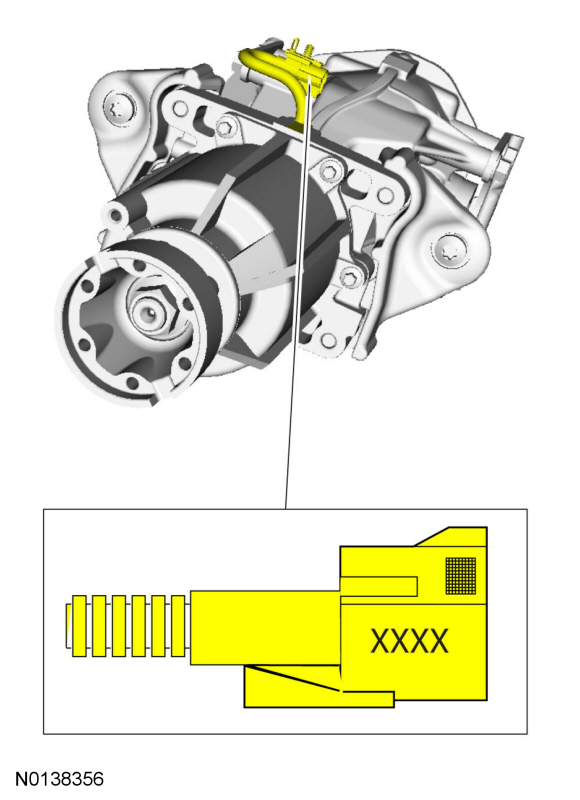
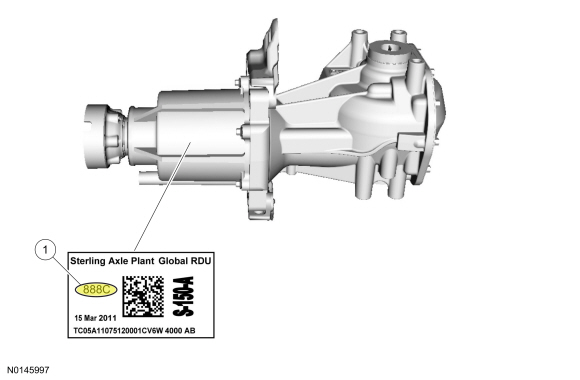
| Item | Description |
|---|---|
| 1 | ATC solenoid bar code |
Carry out the AWD drive cycle after downloading the ATC solenoid bar code information to the PCM.
NOTE: Always drive the vehicle in a safe manner according to driving conditions and obey all traffic laws.
Inspection and Verification
Visual Inspection Chart
| Mechanical | Electrical |
|---|---|
|
|
DTC Chart
Diagnostics in this manual assume a certain skill level and knowledge of Ford-specific diagnostic practices. Refer to Diagnostic Methods in Section 100-00 for more information.
DTC Chart - PCM
| DTC | Description | Action |
|---|---|---|
| P164D | AWD ID Block Corrupted, Not Programmed | CLEAR the DTC. REPEAT the self-test. If DTC returns, enter the ID located on the RDU and program into the PCM. |
| P181F | Clutch Control System Performance | This an internal AWD relay module fault. INSTALL a new AWD relay module. REFER to All Wheel Drive (AWD) Relay Module . |
| P187B | Tire Size Out of Acceptable Range - AWD Disabled | GO to Pinpoint Test B . |
| P188B | AWD Clutch Control Circuit | GO to Pinpoint Test C . |
| P188C | AWD Relay Module Communication Circuit | CLEAR the DTCs. REPEAT the self-test. If DTC returns, GO to Pinpoint Test D . |
| P188D | AWD Relay Module Feedback Circuit | CLEAR the DTCs. REPEAT the self-test. If DTC returns, GO to Pinpoint Test D . |
Symptom Chart
Diagnostics in this manual assume a certain skill level and knowledge of Ford-specific diagnostic practices. Refer to Diagnostic Methods in Section 100-00 for more information.
In most circumstances, the PCM sets DTCs to help guide with diagnostics. Refer to the DTC Chart before using the symptom chart. The Condition column lists the vehicle condition. The Source column lists a detailed vehicle condition. The Action column lists the action to be performed to determine the cause of the condition. Each action lists the components that can caused the system and the individual components in that system. The components are listed in order of disassembly. Use the list of components and the required action to focus on disassembly inspections for the root cause of the concern.
| Condition | Possible Sources | Action |
|---|---|---|
|
|
|
|
| |
|
| |
|
| |
|
| |
|
|
|
| ||
|
| |
|
| |
|
| |
|
| |
|
| |
|
|
Pinpoint Tests
Pinpoint Test A: AWD System Functional Test
Diagnostics in this manual assume a certain skill level and knowledge of Ford-specific diagnostic practices. Refer to Diagnostic Methods in Section 100-00 for more information. This pinpoint test is intended to diagnosis the AWD system concern without on-demand or continuous DTCs
Refer to Wiring Diagrams Cell 34 , All Wheel Drive (AWD) for schematic and connector information.
The AWD system is an active system, which means it not only responds to wheel slip between the front and rear axles but also has the ability to anticipate wheel slip and transfer torque to the rear wheels before the slip occurs. The AWD system is active all the time and requires no input from the operator. The AWD system continuously monitors vehicle conditions and automatically adjusts the torque distribution between the front and rear wheels. During normal operation, most of the torque is delivered to the front wheels. If wheel slip between the front and rear wheels is detected, if the vehicle is under heavy acceleration or if the vehicle is in an aggressive handling event, the AWD system increases torque to the rear wheels to prevent or control wheel slip. When the AWD system is functioning properly, there should be no perceived speed difference between the front and rear axles when launching or driving the vehicle on any uniform surface. Traction should be similar to a part time 4WD system in 4H ( 4X4 HIGH), but have no binding in turns.
 WARNING: When directed to drive the vehicle as part of this test, drive the vehicle on a hard surface in an area without traffic to prevent a crash. Failure to follow these instructions may result in personal injury.
WARNING: When directed to drive the vehicle as part of this test, drive the vehicle on a hard surface in an area without traffic to prevent a crash. Failure to follow these instructions may result in personal injury.
| Test Step | Result / Action to Take |
|---|---|
| A1 CHECK FOR ATC SOLENOID LOCK | |
| Yes
Keep the engine OFF for at least 10 minutes then repeat the test. CHECK again for wind-up. If no wind-up is found, GO to A3 . If still present, GO to Pinpoint Test e . No GO to A2 . |
| A2 CHECK THE ACCELERATOR PEDAL FUNCTION | |
| Yes
GO to A3 . No REFER to the Powertrain Control/Emissions Diagnosis (PC/ED) manual to diagnose the accelerator pedal position sensor concern. |
| A3 CHECK ABS WHEEL SPEED SENSOR PIDS | |
| Yes
GO to A4 . No REFER to Section 206-09 . |
| A4 CHECK VEHICLE ACCELERATION IN A STRAIGHT LINE | |
| Yes
GO to Pinpoint Test E . No GO to A5 . |
| A5 CHECK VEHICLE TURNING ABILITY | |
| Yes
GO to Pinpoint Test E . No GO to A6 . |
| A6 CHECK TORQUE AT THE REAR WHEELS | |
| Yes
END the active command. End of System Functional Test. No CHECK the PTU . REFER to Section 308-07B . |
Pinpoint Test B: P187B
Diagnostics in this manual assume a certain skill level and knowledge of Ford-specific diagnostic practices. Refer to Diagnostic Methods in Section 100-00 for information about these practices. This pinpoint test is intended to diagnosis the wheels and tires, wheel speed sensors ABS module and PCM.
Refer to Wiring Diagrams Cell 34 , All Wheel Drive (AWD) for schematic and connector information.
The AWD system uses input data from the ABS module wheel speed sensor inputs to the PCM. A dissimilar spare tire size (other than the spare tire provided) or major dissimilar tire sizes or improperly inflated tires between the front and rear axles could cause the AWD system to stop functioning correctly.
DTC Fault Trigger Conditions
| DTC | Description | Fault Trigger Conditions |
| P187B | Tire Size Out of Acceptable Range - AWD Disabled | When the PCM detects an inappropriate size wheels/tires (greater than 7% difference in size across the front and rear axle or greater than 14% difference in size at one wheel on either the front or rear axle) installed. |
 WARNING: When directed to drive the vehicle as part of this test, drive the vehicle on a hard surface in an area without traffic to prevent a crash. Failure to follow these instructions may result in personal injury.
WARNING: When directed to drive the vehicle as part of this test, drive the vehicle on a hard surface in an area without traffic to prevent a crash. Failure to follow these instructions may result in personal injury.
| Test Step | Result / Action to Take |
|---|---|
| B1 CHECK FOR RECENT TIRE USAGE | |
| Yes
Tire size should not exceed OEM recommendations and that all 4 tires should be the same size and brand. REPEAT the self-test. No GO to B2 . |
| B2 CHECK TIRE SIZE AND BRAND | |
| Yes
GO to B3 . No Tire size should not exceed OEM recommendations and that all 4 tires should be the same size and brand. INSTALL new tire(s) as necessary. ROAD TEST the vehicle. |
| B3 CHECK TIRE AIR PRESSURES | |
| Yes
GO to B4 . No ADJUST tire air pressures. ROAD TEST the vehicle. |
| B4 CHECK ABS MODULE WHEEL SPEED SENSORS | |
| Yes
GO to B5 . No The ABS module is sending invalid wheel speed data to the PCM, REFER to Section 206-09 . |
| B5 CHECK FOR CORRECT PCM OPERATION | |
| Yes
INSTALL a new PCM, REFER to Section 303-14 . PROGRAM the PCM with the latest calibration. PERFORM the Solenoid Body Strategy Data Download procedure and PERFORM the Solenoid Body Strategy Drive Cycle, REFER to Section 307-01 . PROGRAM the PCM with the ATC bar code, REFER to Automatic Torque Coupling (ATC) Configuration . PERFORM the AWD Drive Cycle. No The system is operating correctly at this time. ROAD TEST the vehicle and PERFORM the AWD Drive Cycle. |
Pinpoint Test C: P188B
Diagnostics in this manual assume a certain skill level and knowledge of Ford-specific diagnostic practices. Refer to Diagnostic Methods in Section 100-00 for information about these practices. This pinpoint test is intended to diagnosis the wiring, terminals, connectors, AWD relay and PCM.
NOTE: Fuse 70 (15A) is HOT at all times and protects multiple components. Check related systems that may be inoperative.
Refer to Wiring Diagrams Cell 34 , All Wheel Drive (AWD) for schematic and connector information.
The AWD system uses data from other systems as inputs to the PCM. The PCM uses the inputs to determine the appropriate time to send a signal and have the AWD relay energize the ATC solenoid.
DTC Fault Trigger Conditions
| DTC | Description | Fault Trigger Conditions |
| P188B | AWD Clutch Control Circuit | When the PCM detects an open, a short to ground or voltage on the active torque control coupling solenoid voltage supply and or return circuit. |
| Test Step | Result / Action to Take | ||||||||||||||||
|---|---|---|---|---|---|---|---|---|---|---|---|---|---|---|---|---|---|
| C1 CHECK THE ATC SOLENOID CIRCUITS | |||||||||||||||||
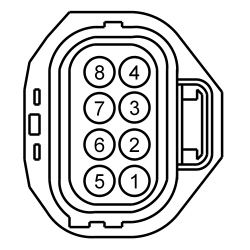 | Yes
INSTALL a new AWD relay module. REFER to All Wheel Drive (AWD) Relay Module . No If the resistance is less than 1 ohm, repair the circuit for a short to ground. If the resistance is greater than 5 ohms, GO to C2 . | ||||||||||||||||
| C2 CHECK THE ATC SOLENOID CIRCUITS FOR AN OPEN | |||||||||||||||||
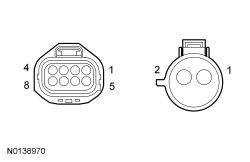 | Yes
GO to C3 . No REPAIR the circuit. | ||||||||||||||||
| C3 CHECK THE ATC SOLENOID CIRCUITS FOR A SHORT TO GROUND | |||||||||||||||||
 | Yes
GO to C4 . No REPAIR the circuit. | ||||||||||||||||
| C4 CHECK THE ATC SOLENOID CIRCUITS FOR A SHORT TOGETHER | |||||||||||||||||
 | Yes
GO to C5 . No REPAIR the circuit. | ||||||||||||||||
| C5 CHECK THE ATC SOLENOID CIRCUITS FOR A SHORT TO POWER | |||||||||||||||||
 | Yes
REPAIR the circuit. No GO to C6 . | ||||||||||||||||
| C6 CHECK THE ATC SOLENOID | |||||||||||||||||
 | Yes
INSTALL a new PCM. REFER to Section 303-14 . PROGRAM the PCM with the latest calibration. PERFORM the Solenoid Body Strategy Data Download procedure and PERFORM the Solenoid Body Strategy Drive Cycle, REFER to Section 307-01 . PROGRAM the PCM with the ATC solenoid bar code information, REFER to Automatic Torque Coupling (ATC) Configuration . PERFORM the AWD Drive Cycle. No INSTALL a new rear axle. REFER to Section 205-02 . PROGRAM the PCM with the ATC solenoid bar code information. REFER to Automatic Torque Coupling (ATC) Configuration . PERFORM the AWD Drive Cycle. | ||||||||||||||||
Pinpoint Test D: P188C and P188D
Diagnostics in this manual assume a certain skill level and knowledge of Ford-specific diagnostic practices. Refer to Diagnostic Methods in Section 100-00 for information about these practices. This pinpoint test is intended to diagnosis the wiring, terminals, connectors, AWD relay and PCM.
NOTE: Fuse 70 (15A) is HOT at all times and protects multiple components. Check related systems that may be inoperative.
Refer to Wiring Diagrams Cell 34 , All Wheel Drive (AWD) for schematic and connector information.
The AWD system uses data from other systems as inputs to the PCM. The PCM uses the inputs to determine the appropriate duty cycle to send to the AWD relay on the command circuit and returns AWD relay information on the feedback circuit.
DTC Fault Trigger Conditions
| DTC | Description | Fault Trigger Conditions |
| P188C | AWD Relay Module Communication Circuit | When the PCM detects an open, a short to ground or voltage on the command circuit. |
| P188D | AWD Relay Module Feedback Circuit | When the PCM detects an open, a short to ground or voltage on the feedback circuit. |
| Test Step | Result / Action to Take | ||||||||||||||||
|---|---|---|---|---|---|---|---|---|---|---|---|---|---|---|---|---|---|
| D1 CHECK FOR AWD RELAY VOLTAGE | |||||||||||||||||
 | Yes
GO to D4 . No GO to D2 . | ||||||||||||||||
| D2 CHECK FUSE 70 (15A) | |||||||||||||||||
| Yes
GO to D3 . No REPAIR the circuit. | ||||||||||||||||
| D3 CHECK THE AWD RELAY POWER CIRCUIT FOR AN OPEN | |||||||||||||||||
 | Yes
GO to D4 . No REPAIR the circuit. | ||||||||||||||||
| D4 CHECK THE AWD RELAY GROUND CIRCUIT FOR AN OPEN | |||||||||||||||||
 | Yes
For 3.5L Ti-VCT GO to D5 . For 3.5L GTDI GO to D6 . No REPAIR the circuit. | ||||||||||||||||
| D5 CHECK THE AWD RELAY COMMAND AND FEEDBACK CIRCUITS FOR AN OPEN | |||||||||||||||||
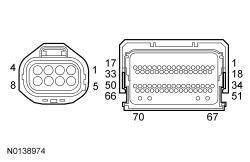 | Yes
GO to D7 . No REPAIR the circuit. | ||||||||||||||||
| D6 CHECK THE AWD RELAY COMMAND AND FEEDBACK CIRCUITS FOR AN OPEN | |||||||||||||||||
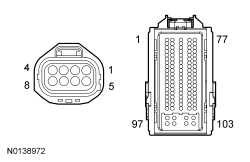 | Yes
GO to D7 . No REPAIR the circuit. | ||||||||||||||||
| D7 CHECK THE AWD RELAY COMMAND AND FEEDBACK CIRCUITS FOR A SHORT TO GROUND | |||||||||||||||||
 | Yes
GO to D8 . No REPAIR the circuit. | ||||||||||||||||
| D8 CHECK THE AWD RELAY COMMAND AND FEEDBACK CIRCUITS FOR A SHORT TOGETHER | |||||||||||||||||
 | Yes
GO to D9 . No REPAIR the circuit. | ||||||||||||||||
| D9 CHECK THE AWD RELAY COMMAND AND FEEDBACK CIRCUITS FOR A SHORT TO POWER | |||||||||||||||||
 | Yes
REPAIR the circuit. No REPLACE the AWD relay module. REFER to All Wheel Drive (AWD) Relay Module . RUN the self-test. If DTC P188C and/or P188D return, REPLACE the PCM. REFER to Section 303-14 . PROGRAM the PCM with the latest calibration. PERFORM the Solenoid Body Strategy Data Download procedure and PERFORM the Solenoid Body Strategy Drive Cycle, REFER to Section 307-01 . PROGRAM the PCM with the ATC solenoid bar code information, REFER to Automatic Torque Coupling (ATC) Configuration . | ||||||||||||||||
Pinpoint Test E: Vehicle Binds in a Turn or Resists Turning/Pulsates or Shudders in a Straight Line
Diagnostics in this manual assume a certain skill level and knowledge of Ford-specific diagnostic practices. Refer to Diagnostic Methods in Section 100-00 for information about these practices. This pinpoint test is intended to diagnosis the wiring, terminals, connectors, wheels and tires, rear axle, ABS module, PCM and AWD relay.
Refer to Wiring Diagrams Cell 34 , All Wheel Drive (AWD) for schematic and connector information.
The AWD system is an active system, which means it not only responds to wheel slip between the front and rear axles but also has the ability to anticipate wheel slip and transfer torque to the rear wheels before the slip occurs. The AWD system is active all the time and requires no input from the operator. The AWD system continuously monitors vehicle conditions and automatically adjusts the torque distribution between the front and rear wheels. During normal operation, most of the torque is delivered to the front wheels. If wheel slip between the front and rear wheels is detected, if the vehicle is under heavy acceleration or if the vehicle is in an aggressive handling event, the AWD system increases torque to the rear wheels to prevent or control wheel slip. When the AWD system is functioning properly, there should be no perceived speed difference between the front and rear axles when launching or driving the vehicle on any uniform surface. Traction should be similar to a part time 4WD system in 4H ( 4X4 HIGH), but have no binding in turns.
 WARNING: When directed to drive the vehicle as part of this test, drive the vehicle on a hard surface in an area without traffic to prevent a crash. Failure to follow these instructions may result in personal injury.
WARNING: When directed to drive the vehicle as part of this test, drive the vehicle on a hard surface in an area without traffic to prevent a crash. Failure to follow these instructions may result in personal injury.
| Test Step | Result / Action to Take |
|---|---|
| E1 CHECK FOR TORQUE AT THE REAR WHEELS | |
| Yes
REFER to Section 205-00 . No GO to E2 . |
| E2 MONITOR THE CLUTCH STATUS PID | |
| Yes
GO to E3 . No GO to Pinpoint Test C . |
| E3 CHECK FOR THE CORRECT WHEEL SPEEDS USING THE WHEEL SPEED SENSORS PIDS | |
| Yes
GO to E4 . No GO to Pinpoint Test B . |
| E4 MONITOR THE APP PID | |
| Yes
GO to E5 . No REFER to the Powertrain Control/Emissions Diagnosis (PC/ED) manual. |
| E5 CHECK FOR CORRECT AWD RELAY OPERATION | |
| Yes
INSTALL a new AWD relay module. REFER to All Wheel Drive (AWD) Relay Module . PERFORM the self-test. No The system is operating correctly at this time. The concern may have been caused by a loose or corroded connector. PERFORM the self-test. |